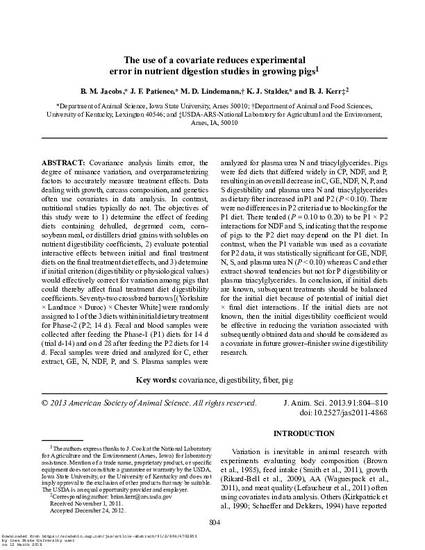
Covariance analysis limits error, the degree of nuisance variation, and overparameterizing factors to accurately measure treatment effects. Data dealing with growth, carcass composition, and genetics often use covariates in data analysis. In contrast, nutritional studies typically do not. The objectives of this study were to 1) determine the effect of feeding diets containing dehulled, degermed corn, corn–soybean meal, or distillers dried grains with solubles on nutrient digestibility coefficients, 2) evaluate potential interactive effects between initial and final treatment diets on the final treatment diet effects, and 3) determine if initial criterion (digestibility or physiological values) would effectively correct for variation among pigs that could thereby affect final treatment diet digestibility coefficients. Seventy-two crossbred barrows [(Yorkshire × Landrace × Duroc) × Chester White] were randomly assigned to 1 of the 3 diets within initial dietary treatment for Phase-2 (P2; 14 d). Fecal and blood samples were collected after feeding the Phase-1 (P1) diets for 14 d (trial d-14) and on d 28 after feeding the P2 diets for 14 d. Fecal samples were dried and analyzed for C, ether extract, GE, N, NDF, P, and S. Plasma samples were analyzed for plasma urea N and triacylglycerides. Pigs were fed diets that differed widely in CP, NDF, and P, resulting in an overall decrease in C, GE, NDF, N, P, and S digestibility and plasma urea N and triacylglycerides as dietary fiber increased in P1 and P2 (P < 0.10). There were no differences in P2 criteria due to blocking for the P1 diet. There tended (P = 0.10 to 0.20) to be P1 × P2 interactions for NDF and S, indicating that the response of pigs to the P2 diet may depend on the P1 diet. In contrast, when the P1 variable was used as a covariate for P2 data, it was statistically significant for GE, NDF, N, S, and plasma urea N (P < 0.10) whereas C and ether extract showed tendencies but not for P digestibility or plasma triacylglycerides. In conclusion, if initial diets are known, subsequent treatments should be balanced for the initial diet because of potential of initial diet × final diet interactions. If the initial diets are not known, then the initial digestibility coefficient would be effective in reducing the variation associated with subsequently obtained data and should be considered as a covariate in future grower–finisher swine digestibility research.
Available at: http://works.bepress.com/john-patience/64/

This article is published as Jacobs, B. M., J. F. Patience, M. D. Lindemann, K. J. Stalder, and B. J. Kerr. "The use of a covariate reduces experimental error in nutrient digestion studies in growing pigs." Journal of animal science 91, no. 2 (2013): 804-810. doi: 10.2527/jas.2011-4868.